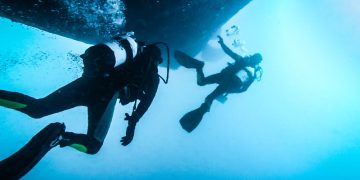Britannia P&I Club has issued guidance and preventative measures regarding bulk storage claims.
Bulk cargo shortage claims are a common yet complex issue, they usually occur when there is a significant discrepancy between the quantity of cargo noted on the Bill of Lading (B/L) and the quantity received at the port of destination.
According to Britannia, such discrepancies can be attributed to various factors, including inaccurate measurement of cargo, improper stowage, mishandling during transport, spillage or even theft.
Prior to loading:
The International Maritime Solid Bulk Cargoes (IMSBC) Code provides comprehensive guidelines for the safe loading, stowage and transportation of bulk cargoes. The first step is to comply with the recommended guidelines stipulated. For example, the cargo hold preparation and cleanliness standards.
Before any cargo is loaded, the ship’s crew must prepare to establish a solid foundation for accurate cargo measurement and documentation.
- Conduct risk assessments prior to loading cargoes with special emphasis on the type of cargo, geographical location and expected weather. For example, a cargo which is susceptible to wet damage will require enhanced weather forecasting and monitoring of conditions to obtain an early warning of rain.
- Obtain detailed planning and instructions from the shipper for cargo stowage, segregation and whether the cargo can be handled in precipitation. The IMSBC Code provides accurate information about the cargo’s characteristics, including the weather precautions, flow moisture point and transportable moisture limit.
- Identify if a Letter of Indemnity (LOI) is being offered for any reason during cargo handling, e.g. to accept an LOI for loading in the rain. If so, the Club should be consulted for technical advice to assess the potential risks and ensure that the terms of the LOI are clear and enforceable.
- Maintain records of hold cleaning progress and consider keeping photographic evidence of the cleaned holds and bilges prior loading. Photographic evidence of cleaned holds and bilges prior to loading can serve as valuable documentation in the event of a dispute.
- Regularly clean and dry bilge wells before loading, then cover them properly to stop cargo from falling in. This helps prevent blockages, protects the drainage system and reduces the risk of damage or contamination during the voyage.
During loading:
Cargo shortage claims often stem from inadequate monitoring during the loading process. Effective supervision should be in place to ensure the cargo is loaded correctly into the correct cargo hold, with the proper grade and quantity planned for.
- A designated officer or crew member should be assigned to carefully supervise loading and unloading operations, such as stevedores using appropriate cargo handling equipment like grab buckets or conveyors, and the proper placement of the cargo in the hold.
- If different types/grades of cargo were mixed or if the cargo was not properly segregated, marked or labelled, it could lead to confusion over the quantity of cargo on board. Clearly segregate.
- Ensure that working cargo holds are closed and sealed (if required) when a delay is anticipated, this may help to maintain the integrity of the cargo and reduces the risk of disputes over quantity loss or contamination.
- The accuracy of weighbridge systems typically ranges from 0.5% to 1.0%, depending on the port. To ensure reliability, the master should request a copy of the weighbridge certificate, which includes details on the system type and its latest inspection or calibration by an ISO-certified inspection company or government authority.
- Sensor issues can occasionally impact the accuracy of the loading apparatus’ weight detection system. Therefore, it is advisable for shipowners to verify the calibration details, if available, at the port of loading.
- An independent surveyor may be used to establish the suitability of the cargo holds prior to loading, the apparent condition of the loaded cargo, and to determine the quantity and quality of cargo loaded. A surveyor may also be employed to assist the master, by conducting tasks such as regularly sampling, testing and documenting the condition of the cargo.
- Draft surveys are essential when confirming the cargo has been accurately measured to determine ship’s figures during loading.
- If the cargo measurement is inaccurate, the reported shortage may be incorrect. This could be due to errors in the measurement process or when the loading survey is carried out at a roadstead, where the weather and sea conditions would render the survey inaccurate. Therefore, it is imperative to maintain draft marks at all times and strive for full accuracy of measurement. If the draft survey is conducted in open or choppy seas, we would recommend issuing a letter of protest (LOP) highlighting the potential inaccuracy of the loaded figures.
- Take measurements of the hold volume, stowage factor and broken stowage to countercheck the amount of cargo loaded in each hold. These measurements provide an additional layer of verification and can help identify discrepancies between the cargo loaded and the figures recorded in the B/L.
- The B/L should accurately state the quantity of cargo and other details, such as the weight, volume, grade and description of the cargo. The B/L figures should consider the water content of the cargo, and if necessary, should be claused to reflect the condition, and record the ships figures for quantity of cargo loaded.
- The correct unit of measurements should be detailed in the B/L to avoid cargo dispute, i.e., claims sometimes arise for certain cargoes being bought / sold in dry metric ton (DMT) but shipped in wet metric ton (WMT). Failing to clarify the unit of measurement can lead to disputes over the actual quantity of cargo delivered.
- Sealing cargo hatches after the completion of loading helps to maintain the cargo’s integrity, prevents unauthorised access and pilferage.
Once the B/L has been signed by the master, it is implied that the quantity and description of cargo is that which is recorded. It is imperative that any discrepancies are brought to the attention of all concerned parties immediately.
During the voyage
During the sea voyage the cargo needs to be protected against apparent damage. This damage could be due to the formation of moisture within the cargo hold or ingress of seawater. Therefore, ship’s crew will need to ensure the cargo remains secured and protected.
With high moisture cargoes, weight loss may be significant in quantity due to discharge of free water. This is especially true when it comes to coal cargo loaded in the rain. The master should ensure that frequent soundings are carried out of the cargo hold bilge wells, with details logged. When necessary to empty water from the cargo hold bilges that has drained from the cargo, the bilge record book should be updated to account for the quantity of bilge water pumped out. To assist with demonstrating the accuracy of these figures, we recommend confirming the volume of bilge wells at various soundings in advance. If any shortage claim arises, then cargo receivers will insist on proof of bilge discharge quantity.
Regularly checking cargo hold seals helps to ensure hold weathertightness and that the cargo remains secure and protected during transport. Damaged or compromised seals can lead to cargo contamination or loss, which may result in disputes over quantity or condition at the discharge port. If for any reason, hold access is necessary, record the breaking of seals, and subsequent replacement.
Ventilation is crucial in protecting cargo from moisture-related damage such as sweating and rust. It is especially important for hygroscopic cargo, like agricultural goods that absorb moisture and spoil easily, as well as non-hygroscopic cargo, which, though less moisture-sensitive, can still be affected by condensation. Effective ventilation reduces humidity, preserves cargo quality, and helps minimise claims.
To manage ventilation, two key rules are followed: the Dew Point Rule, which requires precise humidity measurements, and the Three Degree Rule, which offers a simpler approach by comparing external and cargo temperatures.
Maintaining ventilation logs with cargo temperature, dew points, and ventilation timings is essential for defending against damage claims.
During discharge
Often, the outturn quantity of the bulk cargo discharged is calculated based on a joint draft survey. If the calculated quantity discharged compares favourably with the quantity stated in the B/L, the ship will be unlikely to bear any liability unless the cargo interests dispute the results of the joint draft survey.
The cargo receivers may reject the results of the draft survey and argue that the final outturn quantity of the cargo should be determined by the terminal’s measurement system at the time of delivery.
On other occasions, the discharging method, for instance, discharging of cargo using grabs or conveyor belts may result in some spillage of the cargo discharged. This issue is occasionally exacerbated when the cargo discharged is ‘dumped’ in an open quay stacking area where the receiver will take a longer time to take delivery of the cargo, while exposing the cargo to the inclement weather.
A surveyor may be appointed at the discharge port to certify that seals are intact before breaking with receiver’s/ charterer’s representative invited to attend the verification. This step ensures transparency and helps to demonstrate that all cargo received at the load port, was offloaded at the port of discharge.
Ship’s staff should document the discharging process and preserve available photographic evidence of in-port spillage of cargo due to rough handling or leakage from grabs and trucks. A draft survey should be carried out at every discharge port to account for the amount of the cargo discharge comparing the figures with the actual B/L.
This survey provides an independent verification of the cargo quantity and helps identify any discrepancies. The receiver’s surveyor, if available, should note the discrepancy and total amount of bilge discharge in their final survey report. The findings can be used to support the carrier’s position in the event of an alleged shortage dispute.
Notifications:
In the event of cargo shortage, timely notification and investigation are essential to resolve the issue and mitigate any potential losses.
- The master should notify the cargo owners or shippers immediately, detailing the shortage, such as the quantity and location of the alleged missing cargo. Prompt notification demonstrates the carrier’s commitment to transparency and helps to initiate the claims resolution process.
- Issue a LOP if there is a short loading or discrepancy between the shore figure or quantities from surveys, and if possible, have the LOP signed by cargo interests.
- The master should take immediate steps to mitigate any further losses or shortages, including monitoring the remaining cargo, taking additional soundings, and requesting assistance from shore-based personnel/ surveyor and/or equipment.
Documentations and collecting evidence:
While it is important to make sure the notifications are appropriately carried out, in the meantime, the ship’s crew should ensure all relevant records are maintained and readily available for inspection and verification.
- B/L – verification of the actual quantity of cargo with relevant parties and if necessary, include clauses to address any discrepancies or issues.
- Draft survey records – quantity of cargo actually loaded at loading port and discharged at port of destination.
- Mate’s receipt (MR) – document the condition and quantity of the cargo presented for shipment (ship’s figures); any discrepancies should be worded in the MR.
- Certificate of quality and certificate of moisture content (MC) – in the case where loaded cargoes have high moisture content, then it would be prudent to have the certified documents to compare with the MC in discharging port.
- Empty hold certificate – to certify the hold is completely discharged and will assist in refuting claims of residual cargo.
- Water discharge log or bilge pumping record – keeping record of free water being discharged can confirm the amount of water pumped out from the hold bilge during the voyage, which could be used to confirm the weight loss in shortage claims.
- Cargo and port logbook – document the shortage in the ship’s logbook, details of hatch sealing and hatch open/close timings and prepare a detailed report of the incident.
Other documentation which may be useful:
- Statement of Facts (SOF) from master
- Overtime sheet/ time sheet for hold loading and discharging
- Deck logbook – details of in port/ enroute weather and bunker ROB
- Ballast exchange log – details of water ballast exchange and any change in ballast weight
- CCTV recordings or photographs of port operation, for example visible spiling from the grab etc.
Prevention and responding to bulk cargo shortage claims generally requires a combination of technical expertise, operational diligence and proactive risk management. Therefore, in the event of an alleged claim, timely notification, thorough documentation and collaboration with the Club and local correspondents are very helpful to achieve a favourable resolution.































































